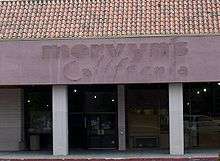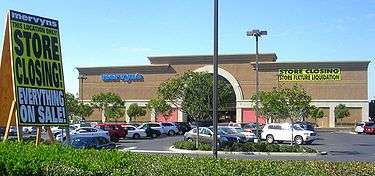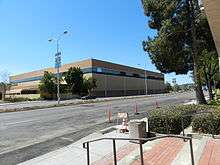Mervyn's
Mervyn's was an American middle-scale department store chain based in Hayward, California, and founded by Mervin G. Morris. It carried national brands of clothing, footwear, bedding, furniture, jewelry, beauty products, electronics, and housewares. Many of the company's stores were created in shopping malls; however some locations were operated independently. Based on 2005 revenue, Mervyn's was the 83rd largest retailer in the United States.[1]
The final logo used from 2004 until the closure | |
| Private | |
| Industry | Retail |
| Fate | Chapter 7 bankruptcy Liquidation sale |
| Founded | July 29, 1949 San Lorenzo, California, U.S. |
| Founder | Mervin G. Morris |
| Defunct | January 1, 2009 |
| Headquarters | , U.S. |
Area served | Southwestern United States |
Key people | John Goodman (CEO, 2008) |
| Services | Sale of clothing, footwear, bedding, furniture, jewelry, beauty products, electronics, and housewares. |
| Owner | Target Corporation (1978-2004) Sun Capital Partners (2004-08) |
| Website | Archive of mervyns.com |
In 2006, Mervyn's had 189 stores in 10 states.[2] One year later, Mervyn's had reduced its store count to 177 stores in seven states. On October 17, 2008, the company announced that it would liquidate its assets through a Chapter 7 filing.[3][4] All remaining locations were closed by the end of the year. The Morris family, having bought back intellectual property rights to the company in 2009, announced plans to relaunch Mervyn's as an internet-based enterprise.[5] The proposed revival never came to fruition.
History
Beginnings
Mervin G. Morris founded the first Mervyn's store in San Lorenzo, California, on July 29, 1949. The store was supposed to be named Mervin's, but the architect suggested that a spelling with a y instead of an i would be more visually appealing. Mervyn's was located in the midst of San Lorenzo Village, a planned residential community between the cities of Hayward and San Leandro, composed of two- and three-bedroom tract homes built between 1944 and the 1950s. Mervyn's carved a niche for itself by having a relatively no-frills shopping environment that reduced overhead, enabling the store to price merchandise lower than competing department stores. Mervyn's also offered significantly-discounted factory seconds of basics such as jeans, T-shirts, underwear and similar garments, as well as household linens, with flaws minor and undetectable by most. During the 1950s and 1960s, this made Mervyn's popular with the young suburban families comprising the majority of San Lorenzo's population. This marketing strategy was later abandoned before Mervyn's expanded beyond its original single location, but Mervyn's remained popular as a lower-priced alternative to national department store chains.
The second Mervyn's store opened about 15 miles (24 km) south as an anchor tenant of the Fremont Hub Shopping Center, one of two regional malls in Fremont, California, in 1962.
Target years and expansion
In mid-1975, Mervyn's operated stores in the following locations, all in California: Alameda, Antioch, Campbell, Capitola, Citrus Heights, Cupertino, Daly City, Dublin, Fremont, Merced, Millbrae, Modesto, Mountain View, Napa, Oakland, Petaluma, Sacramento-Point West and Florin, Salinas, East San Jose and South San Jose, San Lorenzo, San Pablo, Vallejo and Visalia.[6] In October 1975, the chain expanded to southern California, opening stores in Fullerton and Huntington Beach. The Millbrae store location was particularly popular among San Francisco Peninsula customers searching for deals on itchy children's wool pants in the summer months and similar off-season discount items.
By 1978 the company had grown to a chain of more than 50 stores in three states,[7] and Mervyn's was acquired by the Dayton Hudson Corporation (now Target Corporation). Mervyn's kept its separate identity as a Dayton Hudson subsidiary. The average store had 80-130 employees. There was a Store Team Leader (1), Executive Team Leaders (2-4), Department Leaders (7-10), benefited team members (full-time employees not part of the leadership team), and part-time employees. All employees had "credit goals", which referred to the number of customers that opened a Mervyn's credit account. Part-time employees were expected 1 per every 8 hours, and the leadership team was expected 1 per every 40 hours.
Mervyn's entered Florida in 1986 with a store in Lakeland. Mervyn's began major expansions outside of California with Atlanta being the site of a particularly strong expansion campaign, followed by Miami in 1991. Mervyn's, which had not previously had a retail presence in the southern U.S. competed for mall space with JCPenney which later received top anchor spots at the Town Center Mall in Kennesaw, Shannon Mall in Union City (rebuilt as a DHL Distribution Center), and Gwinnett Place Mall in Duluth (now Beauty Master). Stores that were unaffected were those at North Dekalb Mall in Decatur that was taken over by Upton's (Burlington Coat Factory now occupies the store) and North Point Mall in Alpharetta, which became Parisian and was rebuilt as AMC Theatres. This was also likewise done at the same time in Florida where the company sold ten stores to Dillard's which opened at Cutler Ridge Mall in Cutler Ridge (rebuilt as Regal Cinemas), Miami International Mall in Doral, Coral Square in Coral Springs (both are now Kohl's stores just like many of the other former Mervyn's stores today), Boynton Beach Mall in Boynton Beach (Dillard's converted the store into a clearance center using only half of the building), Broward Mall in Plantation, Pembroke Lakes Mall in Pembroke Pines, Melbourne Square in Melbourne, and Lakeland Square Mall in Lakeland (rebuilt as Cinemark and Sports Authority, which closed in 2016), the latter three locations became "double headers" for Dillard's. The locations at Treasure Coast Square in Jensen Beach (demolished for Borders, which closed in 2011 and became H. H. Gregg that closed in 2017) and Pompano Fashion Square in Pompano Beach (rebuilt as Lowe's) did not become Dillard's when being sold to the Little Rock retailer while some stores that weren't included in the deal were sold to other retailers, such as a larger Saks Fifth Avenue taking over an empty store at Town Center Mall in Boca Raton, where Dillard's wanted to open a new store there since its closure in 1995. Mervyn's had withdrawn from both Miami and Atlanta in 1997.[8] During the 1990s, Mervyn's also expanded into Arizona, Colorado, Texas, Michigan, Minnesota, and Washington State.
Mervyn's California; Sale from Target

From 1995 to 2001,[9] the stores were rebranded as Mervyn's California, in an effort to identify with its West Coast roots. A media campaign was launched to publicize the rebranding, with TV commercials and catalogs featuring former San Francisco 49ers' quarterback Joe Montana. The rebranding had little effect on the company's revenues, and the "California" was dropped from the name in 2001, reverting to the original name. The majority of their stores in Texas didn't even consider adding the "California" name to their stores.
In March 2004, Target Corporation announced that they planned to put the Mervyn's and Marshall Field's divisions up for sale to focus on Target stores. Target Corporation was approached by many buyers for both stores but many of the potential buyers saw value only in the real estate. Target refused to sell to the groups that wanted to purchase Mervyn's for the property value only. Target would only consider deals that would not close the company and put the then 30,000 employees out of work. In July 2004, Target Corporation announced that Mervyn's had been sold to a group of investors that included private investment firm and turnaround specialist Sun Capital Partners, Cerberus Capital Management, and real estate investment company Lubert-Adler Management Inc. Rick Leto was named the new president and chief merchandising officer in January 2005.
Store closures prior to bankruptcy

One of the first acts of the new owners was to cease store operations in certain states, with stores in Minnesota being the first to close.[10] Locations in Minnesota were much larger than the normal store of about 80,000 sq ft (7,400 m2); a few had restaurants. The size of these stores, and their proximity to Target Corporation, made the new owners think them unnecessary.
Further store closures were announced in September 2005, as Mervyn's announced that it would begin to focus exclusively on its Western and Southwestern United States markets, and that 62 stores in the Midwest and South would be closed. Prior to the formal announcement, store employees saw weekly shipments shrink and delivery schedules went from 3 days per week to one. Mervyn's stores in Michigan, Oklahoma, and Louisiana were the first to close, in February 2006. 28 stores in Texas, as well as one store in Salt Lake City, Utah, were also closed.[11]
In 2007, an additional 18 stores were closed. Of the stores closed, 17 were in Oregon and Washington, and one in Grand Junction, Colorado, which was the last remaining Mervyn's store in that state.[12]
Bankruptcy and store closures

Signs of financial distress and possible bankruptcy surfaced on July 21, 2008, when the Associated Press reported that Mervyn's had stopped updating its financial status[13] and that the department store's vendors ceased shipping some products, hurting the store's back-to-school season sales efforts. In addition, financing requests were denied by lenders. This raised the possibility of the company having to file for Chapter 11 bankruptcy, or going out of business altogether.[14]
The company made no official comments at the time, but on July 29, 2008, Mervyn's announced that it had filed for Chapter 11 bankruptcy protection in the United States Bankruptcy Court for the Northern District of California.[15][16] Soon, the Chapter 11 case was converted to Chapter 7 liquidation on October 17, 2008. At the time of this announcement 3 stores had just held grand openings only a few months prior to being told they would soon close.
Although the company initially vowed to keep all locations open during the reorganization efforts, the company announced in August 2008 the closure of all 26 underperforming stores.[17] The company hired an outside company to assist in the liquidation of assets from the stores affected.[17] The closures also marked a complete retreat by Mervyn's from the Idaho market, whose sole store in Boise was one of the ones marked for closure. In Texas, a complete retreat was slated from San Antonio, where all three remaining stores were marked for closure,[18] in addition to the closure of the sole stores in Lubbock, Midland, and Odessa.
After these closures, Mervyn's was left with about 150 stores: 16 in Arizona, 121 in California, three each in Nevada and New Mexico, seven in Texas and six in Utah.[17][19]
In September 2008, Mervyn's sued the private equity firms involved in the leveraged buyout of the chain, alleging that the deal had stripped the retailer of its real estate assets, forcing it into bankruptcy. Mervyn's said in the suit that Cerberus Capital Management and its partners had used the increased rent to finance the buyout.[20]
Liquidation

Although the company attempted to undergo reorganization under bankruptcy, Mervyn's ultimately succumbed to the ongoing US recession and announced that it would liquidate its assets through Chapter 7 of Title 11 in the United States Code,[21] stating it "is the best course of action to maximize value for all of the company’s creditors, employees and other stakeholders."[22] The bankruptcy called for the company to liquidate and close its remaining stores.[3] The announcement came amidst an offer by fashion retailer Forever 21 to purchase 149 of the remaining Mervyn's stores for an undisclosed amount. The original negotiations failed, and Mervyn's liquidated all 149 stores under the bankruptcy action. Several months later, department store retailer Kohl's and Forever 21 prevailed in a joint bid at bankruptcy auction to take over the leases of 46 Mervyn's stores; Kohl's has assumed 31 stores, while Forever 21 has assumed 15 stores.[23]
In a KPIX-TV interview on February 11, 2009, Mervin Morris' son Jeff revealed that the family had bought the Mervyn's name and intellectual property, including the company's customer list[5] as part of an effort to relaunch the company. Morris did not say when the website would launch or how much it would cost, only that decisions will be up to his sons. Since 2009, the Mervyn's website has been replaced with a single-page site that allows visitors to sign-up for a mailing list to receive updates about the future of Mervyn's, but was shut down. That website is no longer accessible. The website domain formerly Mervyn's redirects to Appleseed by Blair Apparel.
Legacy
A street named Mervyn's Drive still exists in Fullerton, California, as a Mervyn's location was there prior to 2008.[24]
References
- Top 100 Retailers: The Nation's Retail Power Players (PDF) Archived August 8, 2007, at the Wayback Machine, Stores, July 2006.
- Mervyns.com Store Locator Archived 2016-03-04 at the Wayback Machine
- "Mervyn's Stores Plan To Liquidate, Cease Operations". KPIX-TV (CBS 5). October 17, 2008. Archived from the original on October 17, 2008. Retrieved 2008-10-22.
- Sale Motion filed with the United States Bankruptcy Court, District of Delaware
- "Morris Family Retakes Mervyn's Name, May Make Comeback". 2009-02-11. Archived from the original on 2009-04-15.
- Advertisement, Los Angeles Times (Orange County edition), Sept. 7, 1975, p.OC16.
- Emily Thornton, How Private Equity Strangled Mervyn's, Business Week, November 26, 2008
- Parisian to open in Mervyn's spot at North Point, Atlanta Business Chronicle, April 4, 1997
- "Mervyn's: New California theme is intended to boost sales, profits". The Spokesman-Review. Retrieved 8 June 2013.
- "Target selling Marshall Field's, closing Minnesota Mervyn's stores". Houston Business Journal. June 10, 2004. Retrieved October 9, 2006.
- Zaragoza, Sandra (September 7, 2005). "Mervyns to close 62 stores, exit Houston market". Houston Business Journal. Retrieved October 9, 2006.
- "Mervyn's prepares to close GJ store". The Daily Sentinel. December 27, 2007. Retrieved December 30, 2007.
- "Mervyn's face financial squeeze". The Associated Press (via The Arizona Republic). July 21, 2008. Retrieved July 21, 2008.
- "Mervyn's may be forced to file for Chapter 11: report". CBS MarketWatch. July 21, 2008. Retrieved July 21, 2008.
- "Mervyn's Chapter 11 Petition" (PDF). PacerMonitor. PacerMonitor. Retrieved 15 June 2016.
- Maestri, Nicole (July 29, 2008). "Mervyn's says files for Chapter 11 bankruptcy". Reuters. Retrieved July 29, 2008.
- "Mervyn's announces select store closure as part of reorganization". Mervyn's, LLC. 2008-08-13. Archived from the original on 2016-03-12. Retrieved 2008-08-18.
- "Mervyn's department stores exiting San Antonio". Bizjournals.com. 2008-08-14. Retrieved 2008-08-28.
- "Mervyn's Company Backgrounder". Mervyn's, LLC. 2008-02-01. Archived from the original on 2008-08-02. Retrieved 2008-08-28.
- "Mervyn's says files for Chapter 11 bankruptcy". San Diego Union Tribune. October 8, 2008. Archived from the original on October 31, 2008. Retrieved October 8, 2008.
- Sale Motion filed with the US Bankruptcy Court, District of Delaware
- 10/30/2008 Mervyn's Press Release (www.mervyns.com/AboutDetail.aspx?id=1958)/
- GALLEGO, JULIE (December 12, 2008). "Kohl's, Forever 21 take over Mervyns sites". Orange County Register.
- "Google Maps". Google Maps.
External links
![]()